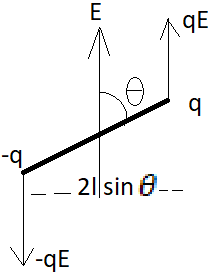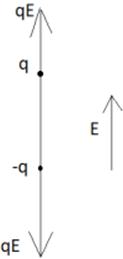This set of Class 12 Physics Chapter 1 Multiple Choice Questions & Answers (MCQs) focuses on “Dipole in a Uniform External Field”.
1. A dipole, having dipole moment \(\vec{p}\) is placed in an electric field \(\vec{E}\). What will be the torque acting on the dipole?
a) \(\vec{p}.\vec{E}\)
b) \(\vec{p}+\vec{E}\)
c) \(\vec{p} \times \vec{E}\)
d) \(\vec{p}-\vec{E}\)
View Answer
Explanation:

Forces on +q and –q charges act along two opposite direction and the perpendicular distance between the two forces is equal to 2lsinθ (as the distance between the two point charges is 2l). Therefore the torque = force*distance=qE*2lsinθ=(q*2l)*E*sinθ. But q*2l is defined as the dipole moment \(\vec{p}\) of the dipole. So the expression of torque becomes \(\vec{p} \times \vec{E}\) according to cross product rule.
2. If an electric dipole is placed in a uniform electric field ______ will act on the dipole.
a) A force but no torque
b) Both force and torque
c) Torque but no force
d) No torque or force
View Answer
Explanation: Dipole is the combination of two equal but opposite charges, kept at a certain distance. If it is placed in a uniform electric field, both the charges will suffer the same but opposite forces on them. As a result, the net force on the dipole becomes zero, but due to equal and opposite forces acting on two different points, there is a net torque acting on the dipole.
3. A dipole is placed in an electric field such that the axis of the dipole is parallel to the electric field. The torque acting on the dipole will be the maximum in this case. The statement is _____
a) True
b) False
View Answer
Explanation:

We know, the torque acting on a dipole of moment p and placed in a field E is equal to \(\vec{p} \times \vec{E}\) which can also be written as p*E*sinθ following the cross product rule. In this case, the field is parallel to the axis of the dipole. Therefore θ=0 and sinθ is also equal to 0. Hence, the torque acting on the dipole will be the minimum i.e. 0. The torque will be maximum if θ=90 degree and so sinθ becomes 1 in that case.
4. If an electric dipole is placed in a non-uniform electric field ______ will act on the dipole.
a) A force but no torque
b) Both force and torque
c) Torque but no force
d) No torque or force
View Answer
Explanation: In the case of a non-uniform electric field, the force acting on both the charges of the dipole will be unequal. So, there will be a net force acting on the dipole in a certain direction. Also, there will be a torque due to two forces acting at two different points. But in case of a uniform electric field, the net force on the dipole will be zero but net torque will be non-zero.
5. An electric dipole will be in stable equilibrium if the angle between the axis of the dipole and the electric field is ________
a) 0 degree
b) 180 degree
c) 90 degree
d) 45 degree
View Answer
Explanation: Torque acting on a dipole is p*E*sinθ where E is the electric field. Now θ is 0 degree, so sinθ becomes 0 and hence no torque acts on the dipole. So in this case, no force or torque acts on the dipole. Therefore it will be the condition of stable equilibrium. In the case of θ=180 degree, sinθ is also 0 but the condition is known as unstable equilibrium i.e. if we rotate the dipole a bit, it will not come back to its initial position.
6. 1uC and -1uC are placed at a distance of 5 cm forming a dipole. What is the amount of torque required to place the dipole perpendicularly to an electric field of 3*105 N/C?
a) 5*10-3 N. m
b) 15*10-3 N. m
c) 1*10-3 N. m
d) 10*10-3 N. m
View Answer
Explanation: Dipole moment of the dipole = 1*10-6*5*10-2 C. m=5*10-8 C. m. Given the electric field-intensity is E=3*105 N/C. Therefore required torque will be p*E*sinθ where θ is the angle between the electric field and the dipole moment = 90 degrees. Therefore torque required in this case will be 5 *10-8*3*105*sin 90 N. m=15*10-3 N. m.
7. If a non-polar substance is placed in an electric field, what will happen?
a) A net dipole moment will be observed
b) The substance will oscillate
c) The substance will orient itself perpendicular to the electric field
d) It will conduct electricity
View Answer
Explanation: A non-polar substance consists of a huge number of dipoles in it, but they are oriented randomly and hence the net dipole moment of the substance becomes 0 and it acts as a non-polar substance. But if it is placed in an electric field, the dipoles present in it will orient themselves in the direction of the field and hence a net dipole moment will be observed, known as induced dipole moment. No current flow or oscillation of the substance will be observed.
Sanfoundry Global Education & Learning Series – Physics – Class 12.
To practice all chapters and topics of class 12 Physics, here is complete set of 1000+ Multiple Choice Questions and Answers.
If you find a mistake in question / option / answer, kindly take a screenshot and email to [email protected]
- Practice Class 11 - Physics MCQs
- Practice Class 12 - Chemistry MCQs
- Check Class 12 - Physics Books
- Practice Class 12 - Mathematics MCQs
- Practice Class 12 - Biology MCQs
